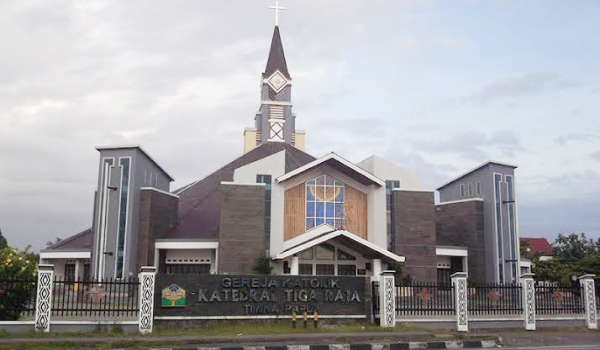
Timika diocese's 102,892 square kilometers cover the eight districts of Papua province. They are Biak-Numfor, Mimika, Nabire, Paniai, Puncak Jaya, Serui, Supiori and Yapen-Waropen.
The mountainous topography of the area makes it difficult to build roads. But despite the difficulty, the government has started to build a Trans-Papua road that connects Nabire town in north coast with Enarotadi in the hinterland of Paniai district. Other towns can only be reached by small planes such as the Cessna 185 operated by Associated Mission Aviation (AMA) which is jointly owned by the Catholic dioceses of Papua.
Timika diocese covers an area of 102,892 square kilometers or 24.38 percent of the total area of Papua's 421,981 square kilometer province. The diocese covers eight districts: Biak-Numfor, Mimika, Nabire, Paniai, Puncak Jaya, Serui, Supiori and Yapen-Waropen.
The Church started in this area on July 11, 1891, when the Dutch colonial ruler allowed the Catholic Church's apostolic vicariate which, based in Batavia (now Jakarta), to operate in southwest Papua.
On May 22, 1894, Jesuit Father Cornelius Le Cocq D'Armandville arrived in Skroe near Fak-fak, Papua. In 10 days he baptized 73 children.
From there, the priest visited Kipia, a coastal hamlet of Mimika district on May 27, 1896. He reportedly was killed there one day at 5 p.m. by crew members of a boat. His body was thrown into the sea. Now the name of the pioneering missioner is used by a Catholic middle school in Kokonao.
The Vatican created the apostolic prefecture of the Netherlands' New Guinea on Dec. 22, 1902, and entrusted it to Missionaries of Sacred Heart priests. The prefecture was based in Langgur, on Kei Island, southeast Maluku. Previously part of Batavia apostolic vicariate, and ministered by Jesuit priests, the prefecture covered areas east of Sulawesi, namely Moluccas and Papua. The first apostolic prefect was Sacred Heart Father Matthias Neyens. The mission area was handed over to Sacred Heart priests on Jan. 1, 1904.
However, evangelization in the area could not continue as the Batavia colonial government, in its Jan. 12, 1912 decree, prohibited Catholic mission work in the north of Papua.
On Aug. 29, 1920, the Vatican elevated the status of the apostolic prefecture to that of apostolic vicariate, and appointed Sacred Heart Father J. Aerts as apostolic vicar. At that time, the vicariate had 7,688 Catholics consisting of 4,884 in Kei, 2,554 in Tanimbar, both in Moluccas, and 250 in Papua. Most of the Catholics in Papua were migrants from Kei and Tanimbar, and Dutch.
Monsignor Aerts, a Father Kowatzky, and Catholic teachers Benedictus Renjaan and Christianus Rettob arrived in Kokonao, May 9, 1928. Renjaan opened a school in Kekwa, Mimika. Since May 27, 1928, Father Kowatzki resided in Kokonao.
In mid 1933, Monsignor Aerts sent a proposal to the Vatican Congregation for the Propagation of the Faith asking for the division of his vicariate into two vicariates. The Vatican congregation gave its reply in December the same year, saying that before the division, there should be a sufficient number of mission stations.
On Sept. 28, 1936, the Vatican congregation permitted the Franciscans to serve in New Guinea vicariate. Five Franciscan priests and one brother were assigned in October 1936 to serve in Papua. The handing over of the pastoral ministry from Sacred Heart to Franciscan missioners took place in Langgur on April 1, 1937. At that time the vicariate had 37,767 Catholics consisting of 16,677 Catholics in Kei, 10,969 in Tanimbar, 667 in Ambon, and 9,454 in Papua.
The development of mission work in Papua prompted the Vatican to divide the Langgur-based New Guinea apostolic vicariate on May 12, 1949, into the apostolic vicariate of Amboina entrusted to Sacred Heart missioners, and Hollandia apostolic prefecture entrusted to the Franciscans. A Father Cremens was appointed June 3, 1949, as apostolic prefect of Hollandia (now Jayapura).
One year later, on June 24, 1950, the Vatican set up the apostolic vicariate of Merauke, with Father H. Tillemans as its apostolic vicar. Thus Papua had two Church regions. On Dec. 19, 1959, the Congregation for the Propagation of Faith elevated the status of Hollandia apostolic prefecture to apostolic vicariate.
On Jan. 3, 1961 Pope John XXIII issued a decree on the establishment of the Church hierarchy in Indonesia and consequently elevated all apostolic vicariates and apostolic prefectures to the status of dioceses and archdioceses. In 1963, Indonesia took over the governance of west Papua from the Dutch. In 1966, the apostolic vicariates of Jayapura and Manokwari-Sorong were elevated to dioceses, while Merauke was made archdiocese. On Dec. 19, 2003, Pope John Paul II approved the establishment of Timika diocese which previously was episcopal vicariate of Jayapura diocese, and appointed Father John Philip Saklil as bishop of the new diocese.